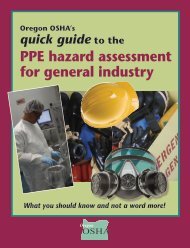Technical Manual - Section 3 (Safety Hazards)
Technical Manual - Section 3 (Safety Hazards)
Technical Manual - Section 3 (Safety Hazards)
Create successful ePaper yourself
Turn your PDF publications into a flip-book with our unique Google optimized e-Paper software.
HYDROCRACKING<br />
Hydrocracking is a two-stage process combining catalytic<br />
cracking and hydrogenation, wherein heavier feedstocks are<br />
cracked in the presence of hydrogen to produce more<br />
desirable products. The process employs high pressure, high<br />
temperature, a catalyst, and hydrogen. Hydrocracking is used<br />
for feedstocks that are difficult to process by either catalytic<br />
cracking or reforming, since these feedstocks are<br />
characterized usually by a high polycyclic aromatic content<br />
and/or high concentrations of the two principal catalyst<br />
poisons, sulfur and nitrogen compounds.<br />
The hydrocracking process largely depends on the nature of<br />
the feedstock and the relative rates of the two competing<br />
reactions, hydrogenation and cracking. Heavy aromatic<br />
feedstock is converted into lighter products under a wide<br />
range of very high pressures (1,000-2,000 psi) and fairly high<br />
temperatures (750-1,500º F), in the presence of hydrogen and<br />
special catalysts. When the feedstock has a high paraffinic<br />
content, the primary function of hydrogen is to prevent the<br />
formation of polycyclic aromatic compounds. Another<br />
important role of hydrogen in the hydrocracking process is to<br />
reduce tar formation and prevent buildup of coke on the<br />
catalyst. Hydrogenation also serves to convert sulfur and<br />
nitrogen compounds present in the feedstock to hydrogen<br />
sulfide and ammonia.<br />
Hydrocracking produces relatively large amounts of isobutane<br />
for alkylation feedstocks. Hydrocracking also performs<br />
isomerization for pour-point control and smoke-point control,<br />
both of which are important in high-quality jet fuel.<br />
HYDROCRACKING PROCESS<br />
In the first stage, preheated feedstock is mixed with recycled<br />
hydrogen and sent to the first-stage reactor, where catalysts<br />
convert sulfur and nitrogen compounds to hydrogen sulfide<br />
and ammonia. Limited hydrocracking also occurs.<br />
After the hydrocarbon leaves the first stage, it is cooled and<br />
liquefied and run through a hydrocarbon separator. The<br />
hydrogen is recycled to the feedstock. The liquid is charged<br />
to a fractionator. Depending on the products desired<br />
(gasoline components, jet fuel, and gas oil), the fractionator<br />
is run to cut out some portion of the first stage reactor<br />
outturn. Kerosene-range material can be taken as a separate<br />
side-draw product or included in the fractionator bottoms<br />
with the gas oil.<br />
The fractionator bottoms are again mixed with a hydro-gen<br />
stream and charged to the second stage. Since this material<br />
has already been subjected to some hydrogen-ation, cracking,<br />
and reforming in the first stage, the operations of the second<br />
stage are more severe (higher temperatures and pressures).<br />
Like the outturn of the first stage, the second stage product is<br />
separated from the hydrogen and charged to the fractionator.<br />
HEALTH AND SAFETY CONSIDERATIONS<br />
Fire Prevention and Protection<br />
Because this unit operates at very high pressures and<br />
temperatures, control of both hydrocarbon leaks and<br />
hydrogen releases is important to prevent fires. In some<br />
processes, care is<br />
Table III:2-12 HYDROCRACKING PROCESS<br />
Feedstocks From Process Typical products..................... To<br />
High pour point Catalytic cracker Decomposition Kerosene, jet fuel......................Blending<br />
residuals Atmospheric, vac. tower Hydrogenation Gasoline, distillates....................Blending<br />
Gas oil Vacuum tower, coker Heavy naphthas Recycle, reformer<br />
Hydrogen Reformer Gas.............................................Gas<br />
plant<br />
III:2-29
















